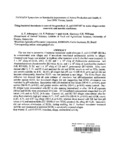Use este identificador para citar ou linkar para este item:
http://www.alice.cnptia.embrapa.br/alice/handle/doc/661221Registro completo de metadados
| Campo DC | Valor | Idioma |
|---|---|---|
| dc.contributor.author | ADESOGAN, A. T. | pt_BR |
| dc.contributor.author | PEDROSO, A. de F. | pt_BR |
| dc.contributor.author | QUEIROZ, O. C. M. | pt_BR |
| dc.contributor.author | WILLIAMS, S. K. | pt_BR |
| dc.date.accessioned | 2011-07-21T01:07:28Z | - |
| dc.date.available | 2011-07-21T01:07:28Z | - |
| dc.date.created | 2010-03-15 | pt_BR |
| dc.date.issued | 2009 | pt_BR |
| dc.identifier.citation | In: FAO/IAEA SYMPOSIUM ON SUSTAINABLE IMPROVEMENT OF ANIMAL PRODUCTION AND HEALTH, 2009, Vienna. Proceedings... Vienna: FAO/IAEA, 2009. | pt_BR |
| dc.identifier.uri | http://www.alice.cnptia.embrapa.br/alice/handle/doc/661221 | pt_BR |
| dc.description | The aim was to determine if bacterial inoculants could eliminate E. coli O157:H7 (ECOL) in contaminated corn silages and if inoculants transferred antibacterial activity to silages. Chopped corn forage was ensiled in triplicate after treatment with:1) distilled water (control); 2) 5 x 105 cfu/g of ECOL (EC); 3) EC and 1 x 106 cfu/g of Pediococcus pentosaceus and Propionibacterium freudenreichii (EC+BII); 4) EC and 1 x 106 cfu/g of Lactobacillus buchneri (LB; EC+LB); 5) EC and 1 x 106 cfu/g of LB and P. pentosaceus (EC+B500). Silos were opened after 3, 7, 31, and 82 d and analyzed for pH and ECOL counts as well as VFA, lactate, and aerobic stability on d 82. By d 3, all silages had pH was <4 (SE=0.33; p=1) and pH did not increase subsequently; therefore ECOL was not detected in any silage. The Kirby-Bauer disc diffusion test showed that all pure cultures of inoculants had pH-independent antibacterial activity against ECOL but inoculated silages did not, suggesting that ECOL elimination was mediated by pH reduction. Inoculation with LB resulted in less lactate (SE=0.31; p<0.05), more acetate (SE=0.35; p<0.05), and greater aerobic stability (SE=7.1; p<0.05) versus control. Day-82 silages were reinoculated with EC at silo opening (immediate) or after 144 h of exposure (delay) and ECOL were enumerated 24 h later. All immediately reinoculated silages had low pH values (<4) and no ECOL 24 h later. Control, EC, and EC+BII silages reinoculated after the delay had relatively high pH values (4.71, 5.67, and 6.03) (SE=0.74; p<0.05) and ECOL counts (2.87, 6.73, and 6.87 log cfu/g) (SE=1.4; p<0.05), whereas those treated with LB had low pH values (<4) and undetectable (EC+B500) or low ECOL counts (1.96, cfu/g; EC+LB). Inoculants did not enhance elimination of ECOL during ensiling, but L. buchneri inoculants increased stability and eliminated or inhibited ECOL in aerobically exposed silages. | pt_BR |
| dc.language.iso | por | pt_BR |
| dc.rights | openAccess | pt_BR |
| dc.subject | Antibacterial activity | pt_BR |
| dc.subject | Maize silage | pt_BR |
| dc.subject | E. coli | pt_BR |
| dc.subject | Inoculant | pt_BR |
| dc.title | Using bacterial inoculants to control the growth of E. coli O157:H7 in maize silages under anaerobic and aerobic conditions. | pt_BR |
| dc.type | Resumo em anais e proceedings | pt_BR |
| dc.date.updated | 2011-07-21T01:07:28Z | pt_BR |
| riaa.ainfo.id | 661221 | pt_BR |
| riaa.ainfo.lastupdate | 2011-07-20 | pt_BR |
| dc.contributor.institution | A. T. ADESOGAN, UNIVERSITY OF FLORIDA/GAINSVILLE; ANDRE DE FARIA PEDROSO, CPPSE; O. C. M. QUEIROZ, UNIVERSITY OF FLORIDA/GAINSVILLE; S. K. WILLIAMS, UNIVERSITY OF FLORIDA/GAINSVILLE. | pt_BR |
| Aparece nas coleções: | Resumo em anais de congresso (CPPSE)  | |
Arquivos associados a este item:
| Arquivo | Descrição | Tamanho | Formato | |
|---|---|---|---|---|
| PROCI2009.00383.pdf | 154.63 kB | Adobe PDF |  Visualizar/Abrir |









